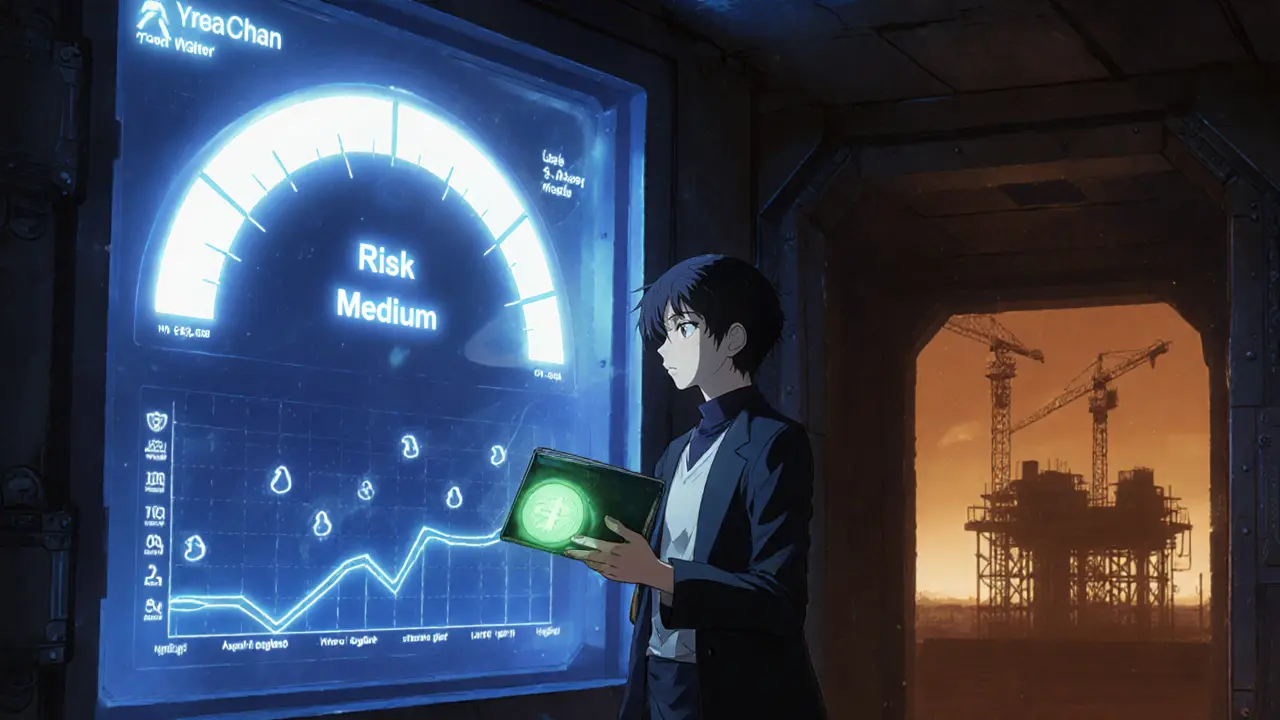Archly Finance Risk & Potential Calculator
Investment Analysis Results
Estimated ARC Tokens Purchased: 0.00
Current Liquidity: $150
Token Price: $0.00001847
Risk Level: Moderate
Potential Upside: Low
Recommendation: Proceed with Caution
Key Takeaways
- Archly Finance is a DeFi protocol, not a traditional centralized exchange.
- Its architecture centers on a cross‑chain DEX, the Rainbow Road layer, and the upcoming Reactor Chain.
- Liquidity is extremely thin - under $200 total - so price moves can be drastic.
- Security audits exist, but smart‑contract risk remains; users must accept legal disclosures.
- Governance runs on veARC, enabling cross‑chain voting once Reactor Chain launches.
When you type "Archly Finance crypto exchange review" into Google, you expect a clear picture of what the platform actually does, how safe it is, and whether it’s worth a look. Below you’ll find a hands‑on breakdown that covers the protocol’s architecture, token economics, real‑world usage, and the risks you should weigh before clicking any "swap" button.
Archly Finance is a decentralized finance (DeFi) protocol that aims to be the first truly cross‑chain ve(3,3) DEX. It builds on the Solidly model, extending liquidity incentives across multiple EVM‑compatible blockchains. The platform’s native token, ARC, serves as both a governance token and, eventually, the gas token on the Reactor Chain.
How the Architecture Fits Together
Archly Finance’s ecosystem consists of three moving parts:
- DEX Platform - a permission‑less liquidity layer that lets any EVM chain list a pool. Protocols can add custom incentives without asking a central authority.
- Rainbow Road - an abstraction layer that handles the heavy lifting for cross‑chain messaging. Think of it as the “bridge” that lets a swap on Ethereum talk to a pool on Binance Smart Chain without each dApp rebuilding the bridge code.
- Reactor Chain - an upcoming EVM‑compatible blockchain designed to host the ve(3,3) mechanics natively. It will be governed by veARC holders.
This three‑tier design is meant to solve two common pain points: (1) fragmented liquidity across chains, and (2) governance silos that lock voting power to a single network. By unifying them, Archly hopes to attract projects that need truly interoperable liquidity.
Tokenomics and the ve(3,3) Model
ARC trades at roughly $0.00001847 and has a circulating supply of about 109million tokens, giving it a market cap under $2k. The fully diluted valuation (FDV) sits near $1.5k, reflecting the tiny token price and low circulation.
The token’s economic engine follows the ve(3,3) framework pioneered by Solidly. Users lock ARC for a chosen period, receiving veARC in return. The longer the lock, the larger the voting power and share of protocol fees. Fees generated by swaps are split between liquidity providers and veARC holders, creating a feedback loop that should, in theory, boost TVL and token value.
Because the protocol is still in early stages, the fee pool is minuscule - under $0.01 per day - so the real incentive comes from future upside once Reactor Chain launches and cross‑chain volume picks up.
Liquidity Landscape and Market Access
Current on‑chain data shows total liquidity hovering between $120 and $174. That’s a drop‑in the pool compared to even modest DeFi projects. The most active pair listed is ARC/WETH, but it reports $0 volume over the last 24hours. In practice, trying to swap a few hundred dollars of ARC can move the price by double digits.
ARC is only available on decentralized aggregators; no centralized exchange lists it. Users must connect a compatible wallet (MetaMask, Trust Wallet, etc.) and interact with the Archly DEX UI or a third‑party router like 1inch. The lack of depth makes it risky for anyone looking to trade large amounts.

Security Posture and Legal Risks
The Archly team has published multiple audit reports from reputable firms. Audits cover contract logic for the DEX, the Rainbow Road messaging layer, and the token contract. While audits reduce known vulnerabilities, they cannot guarantee safety against unknown exploits or governance attacks.
Every interaction requires users to accept a legal disclaimer that absolves the developers of liability. This is standard for DeFi projects but signals that the platform operates in a gray regulatory zone. If you are subject to strict compliance rules (e.g., a U.S. financial institution), you should avoid participation.
Governance Mechanics and Future Roadmap
Once Reactor Chain goes live, ARC holders will be able to lock tokens on any supported chain and still vote on chain‑wide proposals. This cross‑chain governance aims to avoid “voting fragmentation,” a problem observed in projects that rely on a single network for DAO decisions.
The roadmap, as per the official docs, includes:
- Beta launch of Reactor Chain (Q42025 expected).
- Integration with additional EVM chains (Polygon, Avalanche, Fantom).
- Partnerships with bridge providers to improve messaging latency.
- Launch of a UI upgrade that gives visual insight into cross‑chain fee distribution.
There are no concrete dates for these milestones, and the project’s communication channels are relatively quiet, so investors should treat timelines as best‑guess.
How Archly Stacks Up Against Other Cross‑Chain DEXs
Below is a quick side‑by‑side look at Archly Finance versus two well‑known cross‑chain DEXs: Thorchain and Synapse. The table focuses on the criteria most users care about during a review.
| Feature | Archly Finance | Thorchain | Synapse |
|---|---|---|---|
| Core Model | ve(3,3) DEX + cross‑chain layer | Cross‑chain liquidity network (BFT) | Bridge + AMM pools |
| Liquidity (USD) | ~$150 | ~$350M | ~$200M |
| Token Governance | veARC (cross‑chain) | RUNE (single‑chain) | SYN (single‑chain) |
| Permissionless Pools | Yes, any EVM chain | No, curated nodes | Limited to supported chains |
| Security Audits | Multiple audits (public) | Audited by Certik, PeckShield | Audited by Quantstamp |
| Launch Status | Beta DEX, Reactor Chain pending | Live since 2020 | Live since 2021 |
From the table it’s clear that Archly is still in a nascent phase. The huge liquidity gaps mean you’ll likely face slippage that dwarfs what you see on Thorchain or Synapse. However, the ve(3,3) incentive model could become attractive if the team delivers Reactor Chain and draws liquidity providers seeking higher fee shares.
Practical Checklist Before Using Archly
- Verify you are on the official Archly Finance UI (check the domain’s SSL certificate).
- Use a hardware wallet or a well‑secured software wallet to interact with the DEX.
- Start with a small amount (e.g., $10 worth of ARC) to gauge price impact.
- Read the latest audit report - focus on the Rainbow Road messaging contracts.
- Confirm your jurisdiction permits DeFi participation; if in doubt, consult a legal advisor.
Following these steps can help you avoid the most common pitfalls that new DeFi users encounter.
Is Archly Finance Worth Watching?
If you’re hunting for a high‑risk, high‑potential project that tackles interoperability, Archly offers a unique blend of ve(3,3) economics and a dedicated cross‑chain infrastructure layer. The current market data, however, paints a picture of almost negligible activity - total liquidity barely covers a single coffee purchase.
For long‑term believers who are comfortable holding tokens through volatility and who want to be early participants in a governance‑centric ecosystem, there may be upside. For traders looking for immediate depth or for users who can’t tolerate price swings of 30‑plus percent on a $10 trade, the platform is probably not ready yet.
In short, Archly Finance review shows a conceptually strong design hampered by early‑stage execution. Keep an eye on the Reactor Chain launch; that could be the catalyst that turns the thin liquidity into a meaningful market.

Frequently Asked Questions
What is the main purpose of Archly Finance?
Archly Finance aims to provide a fully permissionless, cross‑chain decentralized exchange that uses the ve(3,3) token model to reward liquidity providers and governance participants across multiple EVM networks.
How does the ve(3,3) model work on Archly?
Users lock ARC tokens for a chosen period, receiving vote‑escrowed ARC (veARC). The longer the lock, the larger the voting power and share of protocol fees, creating a positive feedback loop that should boost liquidity and token value.
Is Archly Finance safe to use?
The contracts have undergone several audits, but no smart‑contract system is risk‑free. Users should start with small amounts, keep wallets secure, and stay updated on any new audit findings.
Where can I buy ARC tokens?
ARC is only listed on decentralized exchanges. You’ll need an EVM‑compatible wallet, connect to a DEX aggregator that includes the ARC/WETH pair, and execute a swap. Liquidity is thin, so expect price impact.
When will the Reactor Chain be launched?
The team has indicated a Q42025 target but has not published a detailed timeline. Keep an eye on their official channels for beta releases and testnet updates.


Post Comments (22)
Reading through the Archly Finance deep‑dive feels like wandering a philosophical garden, where each tokenomics blossom hides a deeper question about value and trust. The cross‑chain ambition is poetic, yet the thin liquidity is a stark reminder of reality’s harsh winds. It’s a delicate dance between idealism and market mechanics.
Wow, this review really unpacks the many layers of Archly Finance in a way that even a newcomer can appreciate, and I love how it blends technical analysis with a narrative flair. First off, the concept of a ve(3,3) model stretched across multiple EVM‑compatible chains is truly groundbreaking, suggesting a future where liquidity isn’t siloed but flows like a river through a network of valleys.
Second, the thin liquidity numbers-hovering around a mere $150-serve as both a cautionary tale and a potential golden opportunity for early adopters willing to weather the volatility.
Third, the audits, while reassuring, can’t fully shield users from the unknown risks that always lurk in the shadows of smart contracts, especially when you consider the relatively nascent stage of the Rainbow Road messaging layer.
Fourth, the governance model, with veARC spanning chains, promises a more democratic and inclusive decision‑making process, but only if the Reactor Chain actually materializes on schedule.
Fifth, the tokenomics paint a picture of a token with a minuscule market cap, which could either explode with growth or implode under market pressure.
Sixth, the comparison table against Thorchain and Synapse is stark-Archly’s liquidity is dwarfed, meaning any sizable trade could cause massive slippage, a fact that traders must keep front‑and‑center in their risk assessments.
Seventh, the practical checklist is a solid set of steps that any prudent DeFi explorer should follow before dipping a toe-or a whole foot-into this ecosystem.
Eighth, the consistent emphasis on using hardware wallets and verifying domains underscores the ever‑present security concerns in the DeFi space.
Ninth, the FAQs address the core curiosities in a concise manner, yet they also hint at the larger unanswered questions surrounding the timeline for Reactor Chain.
Tenth, the overall tone of the review balances optimism with a healthy dose of caution, striking a chord with both risk‑averse users and speculative enthusiasts.
Eleventh, the discussion about potential upside being low right now is honest, but it also leaves the door open for future upside should the project execute its roadmap flawlessly.
Twelfth, the mention of cross‑chain governance could set a new standard if other projects adopt similar mechanisms, potentially reshaping the DeFi governance landscape.
Thirteenth, the lack of centralized exchange listings means the token's price discovery is purely driven by decentralized liquidity, a scenario that can be both liberating and perilous.
Fourteenth, the legal disclaimer reminding users of the gray regulatory zone is a necessary reminder that DeFi still operates in a legal twilight.
Fifteenth, all things considered, Archly Finance is a high‑risk, high‑potential experiment that could either be a stepping stone to greater interoperability or a cautionary footnote in DeFi history.
Honestly, the notion of “cross‑chain governance” feels pretentious when the platform lacks any real liquidity.
Hey folks, just a quick heads‑up: if you’re thinking of trying the DEX, start with a tiny amount and watch the price swing like a roller coaster.
Seems like a classic case of hype outpacing reality – thin liquidity, big promises.
From a cultural perspective, the cross‑chain ambition aligns with the broader trend toward interoperability, yet the execution bottlenecks remind us that ideology alone won’t move markets.
Judging by the numbers, the project is still in its infancy; patience is required, but so is scrutiny.
Drama aside, the data tells the story: $150 liquidity means massive slippage on anything bigger than a coffee purchase.
For newcomers, the best practice is to verify you’re on the official site, use a hardware wallet, and only risk what you can afford to lose.
Remember, the upside is low now, but early adopters who can tolerate volatility may benefit when Reactor Chain goes live.
From a technical standpoint, the smart‑contract audit coverage is decent, but unknown vectors still exist.
The ve(3,3) incentive model is intriguing, yet without sufficient TVL the fee pool will remain negligible for the foreseeable future.
👍 The key is to start small, keep your wallet secure, and stay updated on audit reports. 😊
Start tiny watch impact repeat.
The lack of depth is a glaring red flag; any serious trader should steer clear until liquidity improves.
Energy’s high but so is the risk; if you’re curious, dip a few dollars in and see how the price reacts.
Only a nation‑builder would fund such a thin pool; the numbers simply don’t add up for any legitimate investment.
Looks cool but maybe wait for more liquidity before committing any real money.
I appreciate the thoroughness of the review; it’s clear that Archly’s vision is bold, but the practical hurdles are substantial. Anyone diving in should keep risk management front‑and‑center.
💡 While the roadmap sounds promising, the current liquidity crunch means the token’s price is highly volatile – caution is advised. 🚀
It’s just another hype project that will probably fade away.
One might argue that the fleeting nature of such experiments is the very essence of DeFi’s evolutionary process.